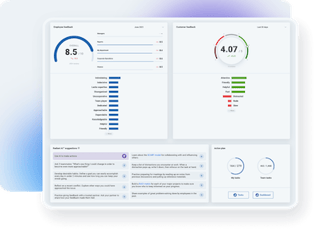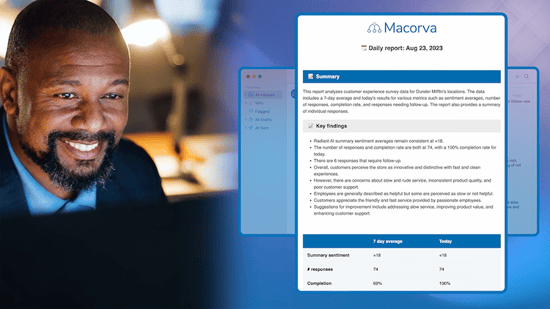
How Businesses Can Tackle the Top 5 Customer Feedback Challenges in 2024
Customer service is the number one factor affecting customer loyalty, according to Forbes’ 2023 customer experience survey. Service is no longer a fix-it shop for queries and concerns or a portal to process product returns – it is now a comprehensive customer experience paradigm that requires businesses to share and embody the values of their target consumers.
Customer feedback is how businesses identify these values, spot gaps in their CX, and evaluate their marketing effectiveness. However, traditional feedback methods like customer satisfaction surveys are no longer enough to track customer needs in real-time, according to studies from the Harvard Business Review. In fact, these outdated methods may be masking core issues with a business’s marketing strategies in addition to misrepresenting their customers’ experiences.
In 2024, the challenges with collecting and interpreting customer feedback are vital concerns for businesses aiming to turn one-time buyers into loyal brand advocates, especially in competitive markets. Emerging technologies, such as generative AI, are revolutionizing feedback collection and utilization. Additionally, the volume of feedback from today's diverse marketing channels is at an all-time high.
To profitably address the modern customer’s complex definition of loyalty, navigate these technological changes, and clarify their multichannel marketing strategies, businesses need to be able to tackle these 5 modern customer feedback challenges.

1. Avoiding qualitative feedback biases
No matter how many channels of feedback your business has (and you should have several), the feedback has to be correctly interpreted, analyzed, and implemented to be valuable. The most successful merchants in the world aren’t those with zero pain points but those who correct them. Amazon and Apple don’t ignore the gaps in their CX – they obsess over them.
A single experience survey is no longer sufficient to quantify your customers’ issues. In fact, overly reductive feedback methods can do more harm than good since many businesses fall into the trap of taking every customer's reaction equally. In other words, they think of feedback as complaints that warrant immediate change and shift their strategies based on an emotion-driven response instead of a data-driven one.
Customer feedback, whether acquired through satisfaction surveys, product reviews, or customer support conversations, merely provides suggestions that could lead a marketing team to discover a trend that needs to be addressed. Businesses that stress over small amounts of feedback or feedback from overly directive surveys risk falling down unprofitable rabbit holes that lead to biases.
For example, many marketing teams fall victim to the “halo effect bias” when assessing customer feedback. This refers to when a non-quantitative impression of a product or service (the customer “liked something”) leads to changes in how the business perceives those aspects to be working. In reality, a positive or negative customer response should not be the basis for a change in practice until that response can be confirmed as a trend in reliable data sources.
Other biases can mislead businesses about the state of their marketing performance due to unreliable reactions. For example, customers may enjoy giving positive feedback to avoid being perceived as difficult, they may provide overly negative feedback since negative experiences are more memorable, or they may act more positively to justify their expenditure (the “sunk cost bias”).
Finally, marketing teams and managers can fall victim to their own confirmation biases when assessing customer feedback. This simply means that they are more likely to confirm a conclusion they already think to be true than to discover one they hadn’t considered.
This is dangerous because it removes problem-solving from your business’s feedback analysis. You may find yourself in a frustrating loop where costly marketing initiatives seem to return good feedback reports from your team yet haven’t made noticeable improvements to your customer retention or conversion rates. If that’s the case in your business, one of these feedback biases may be to blame.

2. Correctly interpreting feedback
Customer feedback is crucial in planning your business’s developmental interventions and marketing tactics. Adapting to changing consumer needs – i.e., changing standards of industry demand – requires a finger on the pulse of those needs, which feedback can provide if it is correctly interpreted.
Even if your team avoids interpretive biases, they still need to know how to identify the relevant trends in the collected feedback. Only then can they recognize which patterns signal areas of improvement and which are outliers that should not be the basis for strategic changes.
The first step in doing this is to focus on feedback that affects areas that your business can change and keep other feedback in perspective. If a customer complains (or compliments) something that you can’t change, you don’t need to worry about that area when preparing your new strategies.
The second step is to look at who is giving the feedback. Just as a valued friend’s advice should mean more than the advice of someone off the street, a long-time customer’s feedback should be more influential in your decisions than a first-time buyer’s. How much customers spend at your business, how often they use your services, and how long they have been loyal to your brand should factor into how seriously your team takes their feedback.
The third step is to take into account the motivation behind the feedback since customers can have different priorities depending on how they approach you. For example, unprompted feedback should be considered a higher priority than the results of compulsory satisfaction surveys. Customers who go out of their way to contact companies are more likely to have valuable insight than those who answer questionnaires because they feel they have to.
However, businesses should keep in mind that unsolicited feedback is usually an extreme experience, whether positive or negative. While significant, this feedback should be balanced with the “average” take, or the responses of customers who don’t necessarily go out of their way to praise and complain, which is where your surveys and social media campaigns come in.
Finally, your team should look at the volume and repetition of the feedback patterns to assess their value. Multiple observations on the same issue should be weighted more, especially when it’s something you’re already aware of. A lot of companies get into a bad habit of expecting to hear certain complaints and ignoring them due to this repetition. A common example is a software company that ignores feedback that mentions a well-known bug.
Well-known feedback should be reassessed as crucial to new initiatives. If numerous customers, particularly loyal ones, have expressed the same feedback on the same issue, your business should consider it a valid basis for strategic changes to your CX.

3. Personalizing Feedback Methods
Personalization is a hyper-important term for modern businesses. 86% of customers say that the effort that goes into personalization impacts their decision on which companies to support. With all the customer data gathered by feedback, businesses should be evolving their idea of personalization to meet these expectations.
Examples of personalization now include automated product recommendations, personalized email marketing, and one-on-one chats with advanced service bots. Customer service can no longer be limited to cold calls. Businesses equipped with a social media infrastructure, data collection methods, and feedback channels should be figuring out how to offer the CX their customers want in 2024 and beyond. After all, 93% of customers become repeat customers when they experience optimized customer service, which today means being approached on a personal level and rewarded for loyalty.
With more options than ever for which businesses they can support, customers’ willingness to trust new businesses is eroding. Feedback helps you understand preferences to create a tailored CX that goes beyond the simple personalization tactics of the past. Today, customers expect to be contacted on their preferred channel of communication, which in a broader sense means they are looking for businesses that will put in the effort to have personalized interactions with them.

4. Leveraging Trending Technology
Organizing customer feedback into useful strategies can be a burden for any team in a business of any size. AI and machine learning have left a lasting impact on how businesses analyze feedback by customizing and automating labor-intensive data tasks to get the most accurate data possible.
Technology like Macorva’s Radiant AI® enables businesses to get tailored reports for their unique organizational needs and observe the results on customizable dashboards. It helps businesses generate actionable strategies by analyzing brand performance through personalized, responsive surveys.
Businesses equipped with modern AI feedback analysis tools like this are getting quantitative and qualitative feedback tailored to their strategic objectives and needs in seconds. Conventional feedback technologies simply can’t keep up.
Consider the role that AI-powered chatbots have assumed in customer service. When properly trained, AI chatbots can use real customer queries to create and deploy new customer service workflows. Consider this case study of an accountancy firm conducted by Indeed, which demonstrated AI as a tool for personalizing marketing initiatives to reach target consumers more effectively.
AI holds a similar promise for analyzing the feedback gathered from those customer service exchanges. It can track customer needs in real-time and methodically tailor an omnichannel CX strategy to your market.
Despite how useful this can be, more data also means more responsibility. A versatile CX requires a versatile feedback analysis system that can organize the insights into customized reports - delivering targeted response plans directly to the inbox of you and your team so the information doesn’t overwhelm you. It’s not enough to “have” data anymore – it must be organized into actionable patterns to be worth anything.

5. Maintaining Omnichannel Feedback
The last major customer feedback challenge is maintaining an omnichannel feedback network that gives customers the experience they want on the communication channels they prefer to use. Businesses now know that with so many potential feedback channels, maintaining a wide net is a necessary part of providing a personalized CX. Some examples of important feedback channels include:
- Email polls and surveys
- Online forums
- Social media questions or polls
- Social media comments
- Customer support queries
- Call recordings
However, the source or channel of the feedback is only half the battle. Companies also need to balance the types of feedback they collect, analyzing and deriving insight from a varied structure of different datasets (this is where modern modeling techniques come into play).
For example, companies have known how to use “direct” sources of feedback for a long time. These include surveys, polls, market research, forums, etc. This feedback is almost always solicited and is usually a direct answer to questions the marketing team has about their solutions.
In comparison, “indirect” feedback channels, which include social media and blog comments, emails, call records, and agent notes, provide mostly unsolicited feedback. Both solicited and unsolicited feedback have a place in a modern marketing strategy, but companies should pay special attention to unsolicited feedback. The reason is that unsolicited feedback is genuine and timely – it captures a reaction as it occurs, rather than when and how a survey farmed it.
Finally, “inferred” feedback, which can be gathered from web searches, contact centers, and store CTAs, is usually more nebulous. Yet, it can still provide valuable insight for companies working through an omnichannel approach that includes all the communication and feedback channels that customers prefer in 2024.

The Takeaway for Businesses
Predictive analysis, personalized surveys, AI and machine learning – these are concepts that will continue coming up in business media for years. As companies learn how to leverage trending technologies against the most pressing problems of managing and analyzing customer feedback from diverse sources, they will be able to save time and energy on labor-intensive customer outreach processes. Machines can now take over social media campaigns, email outreach programs, and more.
With the time saved, it’s up to the business to encourage a culture of continuous feedback and improvement. Using customer feedback, managers can predict future trends and tailor their CX to accommodate the responses that matter most. Telling the difference between meaningful and extraneous feedback is one of several challenges facing businesses with complex customer feedback systems. These are only exacerbated by modern demands for an omnichannel approach to customer communication.
Solving these challenges can lead to the feedback strategies businesses need to stay on top of their customers’ demand for a personalized, engaged CX. However, only a versatile feedback analysis program equipped with AI-enabled systems can cut it in a modern setting. Anything less runs the risk of being overwhelmed by data, the modern business’s blessing and curse in the age of personalization.
To learn how Macorva CX can help your business overcome these feedback challenges and improve every customer experience, check out these resources:
- Blog - Using generative AI to transform customer feedback into action
- Video - Act on customer insights immediately with Radiant AI CX Reports
- Case study - Maximizing customer survey participation at Launchpad

Macorva
Macorva is dedicated to helping you not only gather unfiltered data, but make sense of it. Our industry-leading team of software developers never stops refining Macorva to pick up on subtleties that can help you build a better business.




